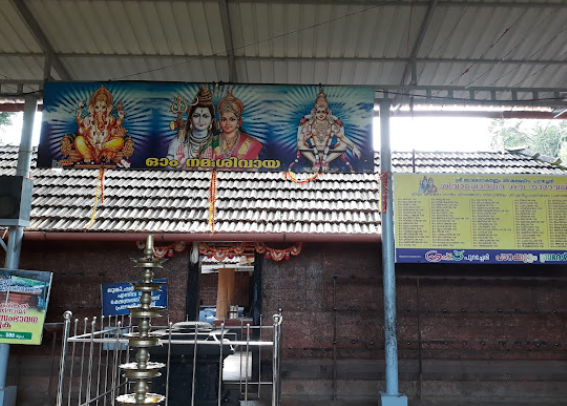The Purachery Balagokarnam Siva Temple is situated in Kerala, India. The temple is believed to have ancient origins, with its roots tracing back to several centuries ago. It is said to have been established by local devotees who experienced divine visions or signs, prompting them to build a shrine dedicated to Lord Shiva. Over time, the temple gained prominence and became a significant spiritual centre for the surrounding communities. The architecture and rituals have been preserved to maintain its traditional sanctity. The temple hosts various festivals, attracting devotees from far and wide, particularly during Maha Shivaratri. Its serene location and spiritual ambiance make it a cherished place of worship.

Balagokarna Kshetram
The Purachery Balagokarnam Siva Temple is located in Kerala, India. It is a revered temple dedicated to Lord Shiva, known for its serene and spiritual ambiance. The temple architecture reflects traditional Kerala style, with intricate carvings and a peaceful atmosphere. Devotees visit this temple to seek blessings and participate in various rituals and festivals dedicated to Lord Shiva.
Timings
Morning: 5:30.AM to 12:00.PM & Evening: 5:00.PM to 8:00.PM
Entry Fee
No entry fee is charged
Do's and Don'ts
- Dress Modestly: Wear clean clothes that cover your shoulders and knees as a sign of respect for the sacred place.
- Remove Footwear: Take off your shoes before entering the temple grounds to keep the temple clean and show respect.
- Wash Your Hands: Use the designated hand washing area near the entrance to cleanse your hands before entering the temple.
- Be Respectful: Maintain a quiet and reverent demeanour; avoid loud talking, laughing, or using your phone.
- Follow the Queue: Wait patiently in line if there is a queue to enter the inner sanctum.
- Observe Rituals: Watch how others behave or ask a priest or devotee for guidance if unsure about a particular practice.
- Respect Sacred Practices: Follow all religious and cultural practices, including dress codes, conduct, and rituals.
- Support Preservation Efforts: Contribute financially or volunteer to support the temple’s maintenance and preservation.
- Spread Awareness: Educate others about the temple’s significance and the importance of its preservation.
- Follow Guidelines: Adhere to the temple’s rules and guidelines, including areas where photography is allowed or prohibited.
- Participate in Rituals: Engage respectfully in rituals and festivals to honour the temple’s cultural and spiritual heritage.
- Maintain Cleanliness: Keep the premises clean and dispose of waste properly.
- Respect Local Customs: Understand and follow local customs and practices related to temple visits and worship.
- Contribute to Community Efforts: Support community initiatives related to the temple and its activities.
- Document and Preserve: Help document the temple’s history and architecture to aid in preservation and education.
- Practice Tactfulness: Be mindful of the temple’s atmosphere and respect the tranquillity of the space, especially during worship times.
- Wear Revealing Clothing: Avoid shorts, skirts above the knee, or sleeveless shirts.
- Bring Leather Items: Leather belts, bags, or wallets are often not allowed in temples due to reverence for cows in Hinduism.
- Consume Food or Drink: Eating or drinking is generally not permitted inside the temple; use designated areas outside if available.
- Smoke or Chew Gum: Smoking and chewing gum are disrespectful on temple grounds.
- Take Photos (Unless Allowed): Do not take photographs in restricted areas or during rituals without permission.
- Touch Deities or Statues: Avoid touching or handling sacred items and deities unless permitted or part of a ritual.
- Point or Gesture Disrespectfully: Avoid making disrespectful gestures or pointing fingers at deities or devotees.
- Litter: Do not leave trash or litter on the temple grounds; dispose of waste responsibly.
- Engage in Non-Religious Activities: Avoid using the temple space for non-religious activities or personal gatherings.
- Neglect Maintenance: Do not contribute to the temple’s deterioration; ensure personal activities do not harm its upkeep.
Dress Code
For Men: Wear clean, modest clothing that covers the shoulders and knees; traditional attire like dhotis or trousers and shirts are preferred.
For Women: Wear attire that covers the shoulders and knees, such as sarees, salwar kameez, or long skirts and tops.
How to reach
By Air : Kannur International Airport (approximately 55 km from the temple). From the Airport, you can take a taxi or hire a cab to reach the temple.
By Train : Kannur Railway Station (approximately 30 km from the temple). From the Station, you can hire a taxi or take a local bus to reach the temple.
By Road : From Kannur City, drive towards Purachery, following local road signs or GPS directions. The temple is well-connected by road.
Nearby Cities and Rivers
Rivers :
- Perumba River : The Perumba River, also known as the Perumpuzha, is a significant river in the Kannur district of Kerala. It flows through the region, supporting local agriculture and contributing to the area's lush greenery.
Cities :
- Kannur: The nearest major city, approximately 10-15 kilometres away, known for its historical and cultural significance.
- Thalassery: About 30 kilometres to the north, famous for its historical landmarks and spice trade heritage.
- Payyannur: Roughly 40 kilometres to the north, known for its traditional temple architecture.
- Iritty: Around 30 kilometres to the northeast, known for its scenic beauty and hilly terrain.
- Panoor: Approximately 30 kilometres to the east, known for local industries and agriculture.